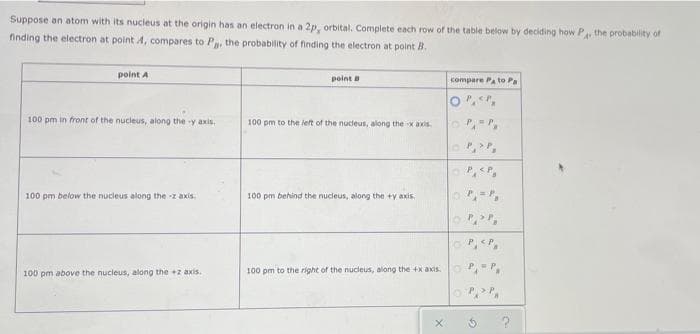Suppose an atom with its nucleus at the origin has an electron in a 2p, orbital. Complete each row of the table below by deciding how P the probability of finding the electron at point A, compares to P, the probability of finding the electron at point B. point A point a compare Pa to P. 100 pm in front of the nucleus, along the y axis. 100 pm to the left of the nudeus, along the x axis o ,P, 100 pm below the nucleus along the -z axis, 100 pm behind the nucleus, along the +y axis, 100 pm above the nucleus, along the +z axis. 100 pm to the right of the nucleus, along the +x axis.
Suppose an atom with its nucleus at the origin has an electron in a 2p, orbital. Complete each row of the table below by deciding how P the probability of finding the electron at point A, compares to P, the probability of finding the electron at point B. point A point a compare Pa to P. 100 pm in front of the nucleus, along the y axis. 100 pm to the left of the nudeus, along the x axis o ,P, 100 pm below the nucleus along the -z axis, 100 pm behind the nucleus, along the +y axis, 100 pm above the nucleus, along the +z axis. 100 pm to the right of the nucleus, along the +x axis.
Chemistry & Chemical Reactivity
10th Edition
ISBN:9781337399074
Author:John C. Kotz, Paul M. Treichel, John Townsend, David Treichel
Publisher:John C. Kotz, Paul M. Treichel, John Townsend, David Treichel
Chapter7: The Structure Of Atoms And Periodic Trends
Section: Chapter Questions
Problem 70SCQ: The ionization of the hydrogen atom can be calculated from Bohr's equation for the electron energy....
Related questions
Question

Transcribed Image Text:Suppose an atom with its nucleus at the origin has an electron in a 2p, orbital. Complete each row of the table below by deciding how P the probability of
finding the electron at point A, compares to P, the probability of finding the electron at point B.
point A
point a
compare PA to Pa
100 pm in front of the nucleus, along the y axis.
100 pm to the left of the nudeus, along the x axis
o ,P,
100 pm below the nucleus along the -z axis,
100 pm behind the nucleus, along the +y axis,
O P,<P,
100 pm above the nucleus, along the +z axis.
100 pm to the right of the nucleus, along the +x axis.
Expert Solution
This question has been solved!
Explore an expertly crafted, step-by-step solution for a thorough understanding of key concepts.
This is a popular solution!
Trending now
This is a popular solution!
Step by step
Solved in 2 steps with 2 images

Knowledge Booster
Learn more about
Need a deep-dive on the concept behind this application? Look no further. Learn more about this topic, chemistry and related others by exploring similar questions and additional content below.Recommended textbooks for you

Chemistry & Chemical Reactivity
Chemistry
ISBN:
9781337399074
Author:
John C. Kotz, Paul M. Treichel, John Townsend, David Treichel
Publisher:
Cengage Learning

Chemistry & Chemical Reactivity
Chemistry
ISBN:
9781133949640
Author:
John C. Kotz, Paul M. Treichel, John Townsend, David Treichel
Publisher:
Cengage Learning

Chemistry: Principles and Practice
Chemistry
ISBN:
9780534420123
Author:
Daniel L. Reger, Scott R. Goode, David W. Ball, Edward Mercer
Publisher:
Cengage Learning

Chemistry & Chemical Reactivity
Chemistry
ISBN:
9781337399074
Author:
John C. Kotz, Paul M. Treichel, John Townsend, David Treichel
Publisher:
Cengage Learning

Chemistry & Chemical Reactivity
Chemistry
ISBN:
9781133949640
Author:
John C. Kotz, Paul M. Treichel, John Townsend, David Treichel
Publisher:
Cengage Learning

Chemistry: Principles and Practice
Chemistry
ISBN:
9780534420123
Author:
Daniel L. Reger, Scott R. Goode, David W. Ball, Edward Mercer
Publisher:
Cengage Learning

Chemistry
Chemistry
ISBN:
9781305957404
Author:
Steven S. Zumdahl, Susan A. Zumdahl, Donald J. DeCoste
Publisher:
Cengage Learning

Principles of Modern Chemistry
Chemistry
ISBN:
9781305079113
Author:
David W. Oxtoby, H. Pat Gillis, Laurie J. Butler
Publisher:
Cengage Learning

Chemistry: An Atoms First Approach
Chemistry
ISBN:
9781305079243
Author:
Steven S. Zumdahl, Susan A. Zumdahl
Publisher:
Cengage Learning